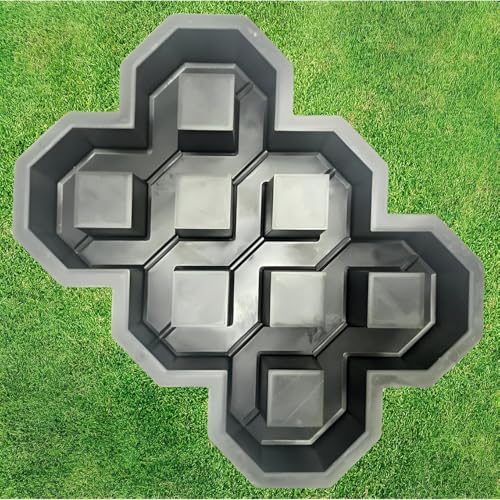When it comes to enhancing the beauty of our outdoor spaces, choosing between natural stone pavers and concrete pavers can be a delightful dilemma. Each option offers unique characteristics that can transform a mundane patio or walkway into a stunning focal point. Natural stone pavers exude a timeless elegance with their organic textures and earthy hues, while concrete pavers provide versatility and durability with a range of shapes and colors to suit any design aesthetic.

In this article, we’ll explore the differences between natural stone pavers and concrete pavers, helping you make an informed decision for your next landscaping project. Whether you’re aiming for a rustic charm or a modern flair, understanding the benefits and considerations of each material will guide you towards creating an outdoor space that reflects your style and withstands the test of time.
Understanding Pavers: Types and Uses
Natural Stone Pavers
When considering natural stone pavers for your outdoor project, we prefer using materials like limestone, bluestone, or travertine. These stones offer a unique elegance and timeless appeal that can elevate any outdoor space. Natural stone pavers are fantastic for creating pathways, patios, or even pool decks. Their organic textures and earthy hues provide a natural charm that blends well with various landscaping styles.
Concrete Pavers
For versatility and durability in outdoor projects, we often recommend concrete pavers. Available in a wide range of shapes, colors, and sizes, concrete pavers allow us to unleash our creativity in design. Whether it’s a modern patio or a traditional walkway, concrete pavers offer the flexibility to adapt to different styles and themes. Their durability ensures that outdoor areas maintain their appeal for years to come.
Durability and Longevity
When it comes to the durability and longevity of natural stone pavers vs concrete pavers, we as landscape designers carefully consider the performance of these materials under various conditions to make the best recommendations for our clients’ outdoor spaces.
Natural Stone Resistance
Natural stone pavers stand out for their exceptional resistance to wear and tear over time. Materials like limestone, bluestone, and travertine exhibit remarkable durability against harsh weather conditions, UV radiation, and heavy foot traffic. Their innate strength and ability to withstand the test of time make them an excellent choice for long-lasting pathways, patios, and pool decks.
Concrete Paver Strength
On the other hand, concrete pavers are renowned for their robust strength and resilience. These pavers are engineered to endure the elements, including freeze-thaw cycles and intense sunlight without losing their structural integrity. With a wide range of shapes, colors, and sizes available, concrete pavers provide versatile options for creating durable outdoor surfaces that maintain their strength and aesthetic appeal for years to come.
In our landscape designs, we focus on selecting materials that not only enhance the beauty of outdoor spaces but also ensure longevity and durability. By understanding the unique resistance and strength characteristics of natural stone and concrete pavers, we can tailor our recommendations to meet the specific needs of each landscaping project.
Aesthetics and Design Flexibility
The Beauty of Natural Stone
When it comes to creating stunning outdoor spaces, natural stone pavers are our top choice for adding a touch of elegance and sophistication. The unique veining, textures, and natural colors of stones like limestone, bluestone, and travertine can truly enhance the aesthetic appeal of any landscape design.
Using natural stone pavers allows us to achieve a harmonious blend with the surrounding environment, creating a seamless transition between the outdoor space and nature itself. Whether we aim for a rustic patio with irregular shapes or a more formal look with uniform stones, natural stone pavers offer endless design possibilities to cater to various styles and preferences.
The Versatility of Concrete Pavers
Concrete pavers, on the other hand, provide us with unparalleled design flexibility and versatility. We can unleash our creativity by choosing from a wide range of shapes, sizes, textures, and colors that concrete pavers offer. Whether we seek a modern, minimalist look or a classic, traditional feel, concrete pavers can be molded to suit any design vision.
With concrete pavers, we can create intricate patterns, including herringbone, basket weave, or running bond, adding a unique touch to outdoor spaces. Their uniform shape and size make them easy to install in different layouts, allowing for quick and efficient construction while maintaining a clean and polished look.
Installation and Maintenance
Installing Natural Stone Pavers
When it comes to installing natural stone pavers, we prioritize precision and attention to detail to showcase their inherent beauty in outdoor spaces. We start by preparing the base, ensuring proper compaction, and laying a sturdy foundation for the pavers. Natural stone pavers, such as limestone, bluestone, and travertine, require special care during installation to maintain their aesthetic appeal.
We carefully set each stone, considering variations in thickness and size to create a cohesive and visually pleasing surface. Grouting natural stone pavers is a delicate process, aiming to secure the stones while preserving their individual characteristics. Proper sealing post-installation is crucial to protect the stones from stains and weather elements, prolonging their lifespan and maintaining their natural allure.
Installing Concrete Pavers
When working with concrete pavers, we embrace the versatility they offer in design and installation possibilities. Concrete pavers come in various shapes, sizes, textures, and colors, allowing for endless creative combinations to bring unique visions to life. Our installation process involves meticulous attention to spacing and alignment to achieve the desired pattern or layout.
Utilizing concrete pavers enables us to experiment with different layout designs, from herringbone to basket weave patterns, enhancing the visual interest of outdoor spaces. We focus on creating a durable and uniform surface that withstands heavy foot traffic and environmental exposure. Sealing concrete pavers after installation helps protect them from color fading and enhances their longevity against wear and tear.
Maintenance Differences
When it comes to maintaining natural stone pavers versus concrete pavers, we approach each material with tailored care strategies. Natural stone pavers require regular cleaning to preserve their natural hues and textures. We recommend using pH-neutral cleaners to avoid damaging the stones and periodic sealing to protect against water penetration and staining.
On the other hand, concrete pavers are relatively low-maintenance, benefiting from occasional pressure washing to remove debris and dirt buildup. Applying a sealant every few years helps enhance the color vibrancy and prolongs the lifespan of concrete pavers. Understanding the maintenance differences between natural stone and concrete pavers allows us to provide clients with comprehensive care guidelines tailored to their specific outdoor landscapes.
Cost Comparison
Initial Costs of Natural Stone and Concrete Pavers
When it comes to choosing between natural stone and concrete pavers for your outdoor landscaping projects, cost is a significant factor to consider. Natural stone pavers, such as limestone, bluestone, and travertine, typically come with a higher initial price tag compared to concrete pavers. The elegance and luxurious feel of natural stone do contribute to this higher cost. On the other hand, concrete pavers are more budget-friendly upfront due to the lower cost of materials and manufacturing processes.
Unveiling the Ultimate Secret: Do You Really Need to Seal Your Travertine Pavers? »
Long-Term Value
While natural stone pavers may have a higher initial cost, they often provide excellent long-term value. Their durability and timeless appeal can increase the overall value of your outdoor space and property. Despite the initial investment, natural stone pavers can last for decades with proper maintenance, making them a sustainable and cost-effective choice in the long run.
On the other hand, concrete pavers, although more affordable initially, may require more frequent maintenance and repairs over time. While they are durable and versatile, they may not retain their aesthetic appeal as effectively as natural stone pavers. Understanding the long-term value of both natural stone and concrete pavers can help you make an informed decision based on your budget and preferences.
Environmental Considerations
As landscape designers, we understand the importance of considering the environmental impact of materials used in outdoor projects. When comparing natural stone pavers to concrete pavers, we assess their eco-friendliness and sustainability to make informed choices that align with our environmentally conscious practices.
Eco-Friendliness of Natural Stone Pavers
Natural stone pavers, such as limestone, bluestone, and travertine, are inherently eco-friendly as they are quarried from the earth’s natural formations. By utilizing natural stone, we reduce the energy consumption typically associated with manufacturing synthetic materials like concrete. Additionally, the durability of natural stone pavers ensures longevity, reducing the need for frequent replacements and minimizing waste generation. When considering the carbon footprint and environmental impact, natural stone pavers stand out as a sustainable choice for outdoor landscaping projects.
Sustainability of Concrete Pavers
Concrete pavers, while versatile and cost-effective, raise concerns regarding sustainability. The manufacturing process of concrete involves significant energy consumption and the emission of greenhouse gases, contributing to environmental pollution. Although concrete pavers can be recycled, the process is not as straightforward as with natural stone pavers, leading to potential waste accumulation in landfills. As landscape designers committed to sustainability, we carefully weigh the environmental implications of using concrete pavers in our projects, considering alternative options that align with our eco-conscious values.
Conclusion
When it comes to choosing between natural stone pavers and concrete pavers for your outdoor landscaping projects, it’s essential to consider the unique qualities of each material. Natural stone pavers offer elegance and timeless appeal, while concrete pavers provide versatility and durability. Cost considerations play a significant role, with natural stone pavers having a higher initial cost but offering long-term value, and concrete pavers being more budget-friendly upfront but potentially requiring more maintenance over time. Environmental factors also come into play, as natural stone pavers are lauded for their eco-friendliness and sustainability, whereas concrete pavers raise concerns about manufacturing processes and waste accumulation. By weighing these factors, you can make informed decisions that align with your landscaping goals and values.
















